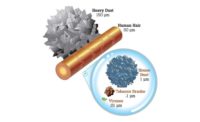One of the key specialized areas of HVAC design is correctional facilities due to their unique challenges. Traditionally, most of the correctional facilities in U.S. lack basic air conditioning. The typical argument is whether or not criminals deserve these amenities or a certain level of comfort. Why should taxpayers' hard-earned money be used for designing these facilities when it could be spent on other issues in society?
Therefore, it is necessary to analyze the correctional facility system. When people think about a correctional facility, most of them imagine hardened criminals who have been convicted of heinous crimes. However, this is not always the case. In addition to the hardened criminal population, there are others such as those dealing with drug addictions or mental health issues.
According to data published by the National Institute of Drug Abuse, an estimated 65% of the United States prison population has an active substance use disorder (SUD). Another 20% did not meet the official criteria for SUD, but were under influence of drugs or alcohol at the time of arrest.
It is important to understand how substance and drug abuse became one of the leading causes of incarceration in correctional facilities. Opioids were introduced in prescription drugs in the late 1990s and many pharmaceutical organizations promised that patients would not be addicted to the pain relievers. This led to health care providers prescribing them at a greater rate, as well as subsequent wide-spread abuse. A large influx of the population in jails by late 1990 were opioid users. In early 2010, the nation faced a rise in heroin overdose among inmates. Recently, another wave of synthetic opioid overdose added a fresh influx of inmates.
Most jails are designed to last 50-100 years. Back when they were designed, engineers did not account for such a large influx of population and design parameters were based on estimated inmate influx before the entry of SUD inmates.
It is necessary that a conducive atmosphere be present to allow for these inmates to recover. Having them in an uncomfortable and hot climate can increase anxiety for these inmates and an anxious inmate is more difficult for the correctional officers to control.
This problem is amplified in hot regions. Lack of air conditioning in hot regions can create unsafe conditions for inmates, exposing authorities and correctional officers to potential enquiries and lawsuits. In 2016, Louisiana spent over one million dollars in legal bills in an attempt to avoid installing air conditioning on death row, an amount four times higher than the actual cost of installing air conditioning. It is interesting to note that out of the 15 hottest states, about 13 lack universal air conditioning. Excessive heat and an uncomfortable atmosphere can cause major issues for people with underlying health conditions. The following data obtained from prisons in Texas projects a grim reality:
Among those convicted:
- 21% are prescribed psychotropic medications;
- 19% are taking medication for high blood pressure;
- 19% have asthma;
- 7% are older than 55; and
- 5% have diabetes.
Due consideration also needs to be provided to correctional officers on duty. Sometimes a jail might be divided into an administrative area and an inmate area and it would be possible to provide air conditioning to the administrative area, which would provide comfort to the correctional officers. However, not all jails may be designed this way. Some of the jail designs involve control stations overseeing dorm rooms, cells, or dayrooms. Typically these control stations are occupied by a correctional officer and these officers usually have very heavy uniforms with stab proof vests as protection against inmates. This would mean that clothing insulation on their body is probably more than that of inmates, thus hampering heat transfer of the skin to atmospheric air to cool the body, which may cause heat exhaustion. There have been multiple instances of officers who have been sent to medical care for heat exhaustion.
The current pandemic also highlighted another area of problem with correctional facilities not having proper air conditioning systems. Correctional facilities are places where inmates are in close contact with each other for a long period of time. Research shows that many of the jails in the United States are overcrowded, so any outbreak of COVID-19 cases in a facility can be lethal since isolating inmates outside of the facility or sending them to other facilities can be really expensive. Many of the jail facilities deployed specialized systems such as bipolar ionization or UV lights in their air conditioning equipment to help reduce the risk of the virus. However, this facility is not available to jails without proper air conditioning equipment.
In conclusion, HVAC may end up playing a huge role in transforming the way correctional facilities work for the betterment of inmates. Every inmate who ends up on the right path is less of a liability for the nation and less of a burden on taxpayers’ money. Correctional facility design should be conducive to help inmates transform for the betterment of society.





